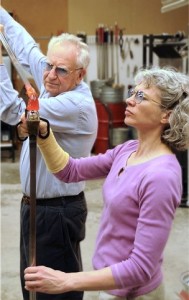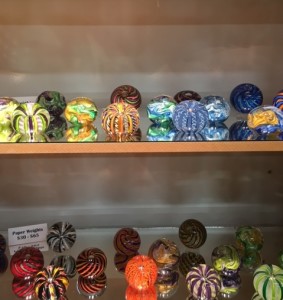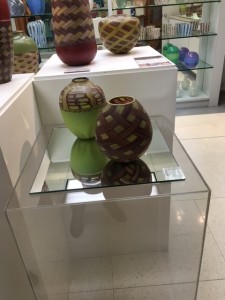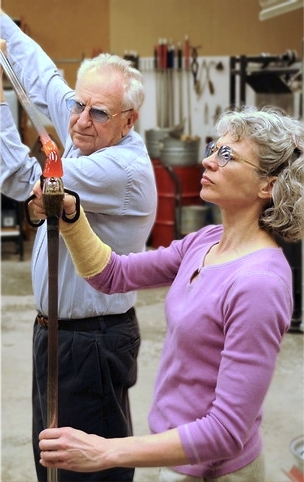
Dick wrote research papers and treated cancer patients with brain tumors as a neurosurgeon in Houston. His reputation for expert treatment for brain cancer caused many sleepless nights. Kathy, his wife, worked as a nurse and physician’s assistant. In 1995 the chance to retire became reality for Dick Moiel and Kathy Poeppel. Since they collected art glass and paperweights, they explored the process of glass art.
The road to their “retirement career” fell into place. They never expected the rich rewards which followed. They built Houston Glass Studio, where they purchased tools and a furnace, dubbed “the glory hole.” Their studio resembles a laboratory for creativity, sometimes referred to as a “hot shop.” In summer, the furnace is off. No longer do they wear sterile clothing in medical facilities but dress in old clothes and suffer from the heat from October through April as they produce an abundance of glass art.
The Interview
I asked Kathy to comment on their “career change” when I attended their Open House:

- What are the key elements in your successful career change?
We haven’t approached glass art as a career. Dick retired from his Neurosurgery practice because it was time to step back from the stress. Glass filled the void which followed. We took time to explore. The whole process of learning and making was invigorating.
- What advice would you give to others in transition to a career in the arts?
Keep it a labor of love.
- What was the most challenging aspect of the career transition?
Trading the confidence and comfortable expertise of a seasoned professional for the humbling, anxious, thrilling opportunities only the total novice can know.
- Did you have mentors who helped you learn the trade at the beginning of your studies?
Once we stumbled onto the path of glass there was no difficulty finding talented teachers. Studio ownership offered unlimited access to glass and the opportunity to practice. Otherwise gaining the skills and understanding of glass as a material would have been a slower process.
- Your resumes show extensive education.
We are professional students: between us we took over 50 classes, at eight schools from 30 different glass artists. Learning in a class environment is essential. Glassblowing is a collaborative process. Watching and talking about glass encourages the hands-on experience. With glass it is possible to learn from someone else’s mistakes.
- Are the classes expensive?
Tuition for a 1 week class will run $500-$1000 plus travel, room and board.

Education and Scholarships
If you are considering a career change you need to hone your skills with specialized training. Universities offer short term classes, conferences and hands-on skill training.
A quick internet search for scholarships lists programs for new and experienced career growth. The premier place to study glass making is Corning Museum of Glass in Corning, New York with world-renowned instructors. Corning offers scholarships.
I belong to the Paperweight Collectors Association of Texas, which provides an annual scholarship to improve the processes for creating paperweights.
Be resourceful in looking for support to improve your chance for less stress and new friends. Research the type of art you find fascinating. Who knows? You may be the next emerging artist with a second or third career.
Take to heart what Kathy says. No career change is easy, but by “keeping it a labor of love,” you find new satisfaction in the world of work.
Their studio is open by appointment during the year with special hours and an Open House in December. Be sure to visit their Houston Studio Glass website for details.
